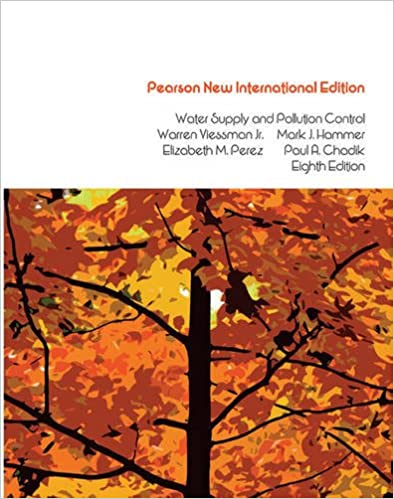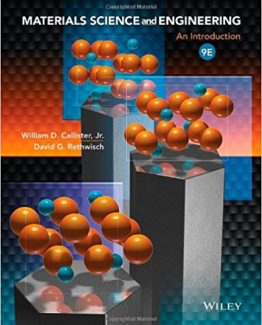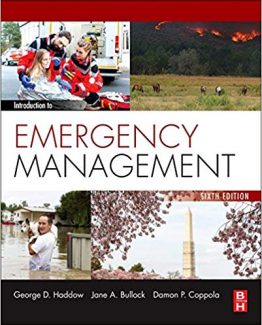Water Supply and Pollution Control 8th International Edition, ISBN-13: 978-1292026077
[PDF eBook eTextbook]
- Publisher: PEARSON HIGHER EDUCATION; 8th edition (January 1, 2004)
- Language: English
- 753 pages
- ISBN-10: 1292026073
- ISBN-13: 978-1292026077
For upper-division undergraduate or beginning graduate courses in civil and environmental engineering.
The Eighth International Edition of this bestselling text has been revised and modernized to meet the needs of today’s environmental engineering students who will be engaged in the design and management of water and wastewater systems. It emphasizes the application of the scientific method to problems associated with the development, movement, and treatment of water and wastewater. Recognizing that all waters are potential sources of supply, the authors present treatment processes in the context of what they can do, rather than dividing them along clean water or waste water lines. An abundance of examples and homework problems amplify the concepts presented.
Features
• The interconnectedness of all potential water sources is illustrated by the text’s wide breadth of coverage – Water development, distribution, and use as well as water and wastewater development are all explored.
• Prominent coverage of monitoring drinking water for pathogens highlights this topic – an increasing concern as the security of drinking water becomes more critical.
• Expanded and updated material on indirect reuse of water for augmenting drinking water supplies gives prominence to this increasingly important component of water resources development.
New to This Edition
• An updated discussion of Geographic Information Systems presents current, practical material on what GIS is and how it can be used to address water issues.
• Revised coverage of Climate Change offers the most up-to-date information on how climate change may affect water resources planning and management.
• A primer on alternative water supply is now included, making this text unique for its concise, comprehensive overview of both traditional and alternative water supply development.
• An expanded treatment of hydraulics includes more definitions as well as coverage of open channel hydraulics and stable channel design.
• A more comprehensive stormwater section examines current stormwater treatment techniques, modeling techniques, and low impact development. Information on modern stormwater management and references for expanded discussion provides students with a well-rounded introduction to modern stormwater management.
• The updated discussion of water quality features the current USEPA regulations which constitute the basis for establishing design goals in drinking water treatment, as well as new discussion of disinfection by-product formation and control.
• Compliance with Total Maximum Daily Loads (TMDLs) is explored, featuring an example and problems. The current USEPA approach to controlling discharge of pollutants to receiving water bodies, and thereby preserving and improving water quality, is also covered. This information can be used as a foundation for the design of wastewater treatment and discharge.
• New and reorganized design standards for sedimentation basins provides standards and criteria from more technical sources. These are more realistic in terms of actual design nowadays than the conservative Ten State Standards sometimes cited elsewhere.
• New filter design methodology takes a simplified approach to the design of rapid rate granular filters. A graphical approach is used to easily size media for successful filtration operation during the backwashing process.
• New and reorganized material on hydrodynamic behavior, chemical kinetics, residence time distributions, and treatment efficiency of chemical reactors is included. This simplifies reactor design and performance evaluation for both ideal and real reactors. Not only is the hydrodynamic behavior of reactors characterized, but the treatment performance of these reactors can be evaluated.
• New treatment of ultraviolet radiation (UV) disinfection features the reduction equivalent dose (RED) analysis that is now used by USEPA in its evaluation of UV disinfection effectiveness. It presents the basics of the latest methodology for evaluating UV disinfection systems under variable water conditions.
• Sections on chlorine-contact time (CT) concept of disinfection effectiveness and the formation and control of disinfection by-products have been updated. The text now offers the most up-to-date information on the analysis of disinfection efficiency, including UV disinfection and the formation and control of disinfection by-products.
• Updated sections on membrane treatment and activated carbon treatment with design equations and methodology provide equations and examples regarding important membrane design parameters such as recovery and rejection as well as activated carbon isotherm analysis to determine minimum dosing requirements.
What makes us different?
• Instant Download
• Always Competitive Pricing
• 100% Privacy
• FREE Sample Available
• 24-7 LIVE Customer Support






Reviews
There are no reviews yet.